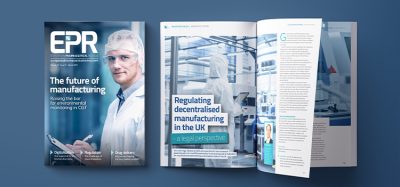Innovation in real-time next-generation sequencing provides pharmaceutical benefits
Posted: 11 January 2021 | Tim Sandle (Bio Products Laboratory and University of Manchester) | No comments yet
Tim Sandle explains how next-generation sequencing (NGS) could aid in the development of novel antimicrobials to overcome multi-drug resistance.


Sepsis is a life-threatening condition that occurs when the body’s immune system overreacts to an infection and begins to damage its own tissues and organs.1 Identifying the causative microbial agent and treating it is essential for treating septicaemia (bacterial infections of the bloodstream – bacteraemia – are the most common forms of sepsis). Finding improved means for accelerating the diagnosis of sepsis is of vital importance to ensure that the patient is administered the correct medicine.2 If the wrong medicine is given, or if the selection of the medicine is delayed, this can result in patient death, depending on the severity as measured by the sequential organ failure assessment score.3 Many diagnostic tests are limited in terms of their time-to-result or they are simply not sufficiently specific to provide the necessary output.
In particular, such technology can assist pharmacogenomics to enhance drug development in sepsis”
A new study has described a novel technique that utilises real-time NGS in order to analyse tiny amounts of microbial cell-free DNA in the plasma of patients with sepsis. This offers both the possibility of accurate diagnosis of sepsis-causing agents within a few hours of drawing blood, as well as a research tool for pharmaceutical drug development.
NGS is a generalised term that captures several different sequencing technologies that share the functionality of allowing for sequencing of DNA and RNA in ways that are faster (and often at a lower cost) than methods that have gone before. The technologies, operating on miniaturised and parallelised platforms, have the capability to query the entire genome (known as the ‘whole genome’), the exons within all known genes (the whole exome) or only exons of selected genes (referred to as the target panel).4 Even with the availability of sequencing methods, most standard-of-care diagnostics around the world continue to rely on microbiological culturing of pathogens. This approach is not only slow, but also has a low success rate.
The new development heralds from Heidelberg University Hospital, Germany, and is based on a diagnostic workflow that uses high-throughput (nanopore) sequencing of microbial DNA.5 Nanopore sequencing works by monitoring changes to an electrical current as nucleic acids are passed through a protein nanopore. The resulting signal is decoded to provide the specific DNA sequence.6 This technology has not previously been considered suitable since nanopore sequencing requires long fragments of DNA and microbial cell-free DNA tends to occur in small fragments and low quantities in a patient’s plasma. This was overcome using a specifically adapted bioinformatic procedure that uses a handheld nanopore sequencer referred to as MinION, a device that reads in real time. It was developed by Oxford Nanopore Technologies, UK,7 and first applied for bloodborne pathogen analysis at the Fraunhofer Institute for Interfacial Engineering and Biotechnology, Germany. The recent innovation involved taking such technology and creating a real-time sequencing-based workflow for the diagnosis of sepsis in terms of throughput, sensitivity, specificity and speed. Workflow development is concerned with composing and executing a series of steps including library preparation, sequencing and data analysis involving computational analysis.


Such a tool is not only of interest to the clinical setting, but it can also help to advance pharmaceutical drug development in terms of empiric and definite development of novel antimicrobials designed to overcome the growth in multi-drug resistance among common pathogenic organisms. In particular, such technology can assist pharmacogenomics to enhance drug development in sepsis, a topic of scientific, regulatory and commercial importance.
About the author
Tim Sandle’s primary role is Head of Microbiology at Bio Products Laboratory, a sterile products manufacturer. In addition, he is a tutor with the School of Pharmacy and Pharmaceutical Sciences at the University of Manchester, for the university’s pharmaceutical microbiology MSc course, and a longstanding committee member of the pharmaceutical microbiology society, Pharmig.
References
- Deutschman CS, Tracey KJ. Sepsis: Current dogma and new perspectives. Immunity. 2014:40(4):463–75
- Chao C, Muming Y, Yanfen C. Pathological Alteration and Therapeutic Implications of Sepsis-Induced Immune Cell Apoptosis. Cell Death & Disease. 2019;10(10):782
- Singer M, Deutschman CS, et al. The Third International Consensus Definitions for Sepsis and Septic Shock (Sepsis-3). JAMA. 2016;315(8):801–10.
- Anderson MW, Schrijver I. Next Generation DNA Sequencing and the Future of Genomic Medicine. Genes. 2010;1(1):38–69
- Grumaz C, Hoffmann, A, et al. Rapid Next-Generation Sequencing–Based Diagnostics of Bacteremia in Septic Patients. The Journal of Molecular Diagnostics. 2020;22(3):405
- Greninger AL, Naccache SN, et al. Rapid metagenomic identification of viral pathogens in clinical samples by real-time nanopore sequencing analysis. Genome Medicine. 2015;7(1):99
- Clarke J, Wu HC, et al. Continuous base identification for single-molecule nanopore DNA sequencing. Nat Nanotechnol. 2009;4:265
Related topics
Microbial Detection, Microbiology, Next Generation Sequencing, Sequencing
Related organisations
Fraunhofer Institute for Interfacial Engineering and Biotechnology, Heidelberg University Hospital, Oxford Nanopore Technologies








